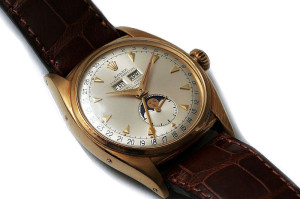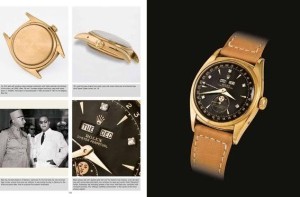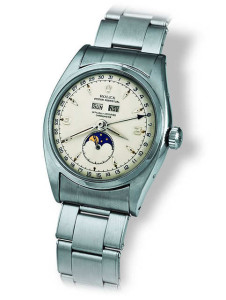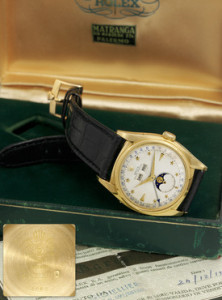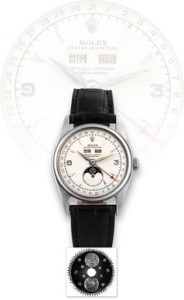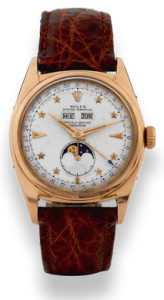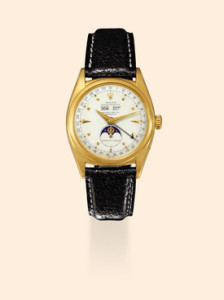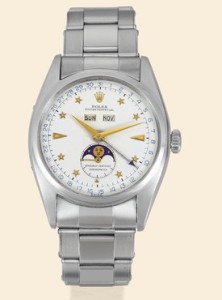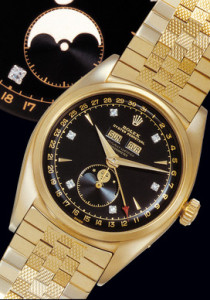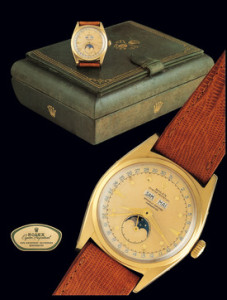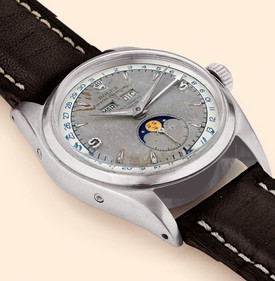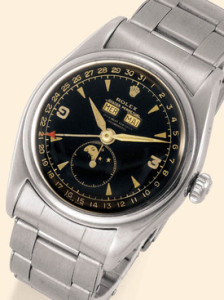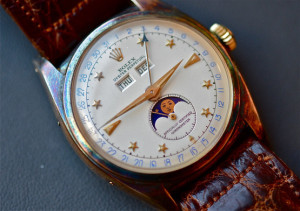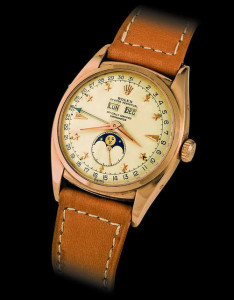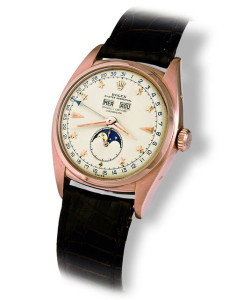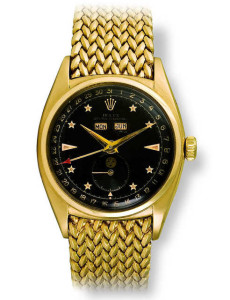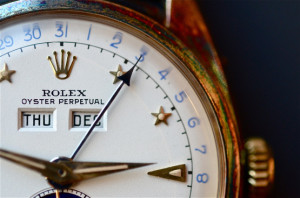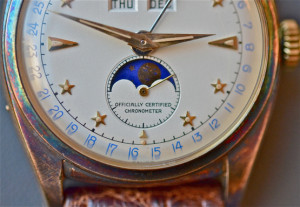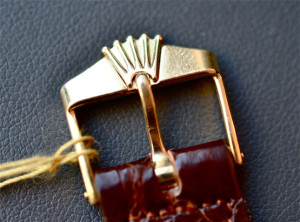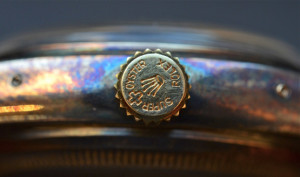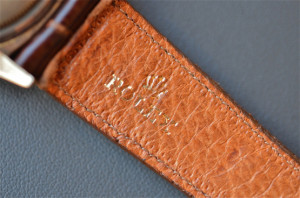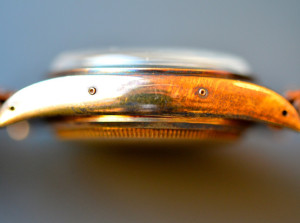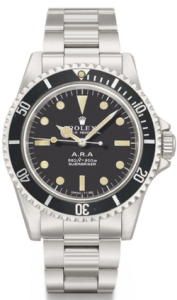
A couple of years ago Auction House Christie’s had a very interesting Rolex for sale. It was a Submariner ref 5514, a model that was made especially for COMEX (Compagnie Maritime d’Expertises). Ref 5514 was never available for the civilian customer.
The difference between the COMEX watch and the civilian version, ref 5513, was the helium escape valve on the left side of the case (similar to the valve on the Sea-Dweller). Of the ref 5514 Submariner only about 150 pieces were made.
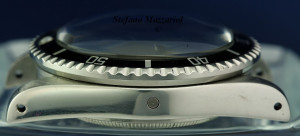
Had this watch just been a ref 5514 made for COMEX than it would have already been very rare but this one was even more special. It had the military markings of the Argentine Navy. The ‘A.R.A.’ on the dial stood for ‘Armada de la Republica Argentina’. The caseback was engraved with both a COMEX number and a military issue number.
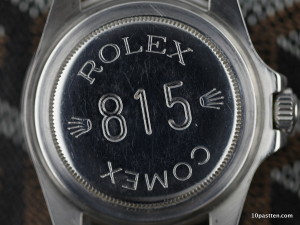
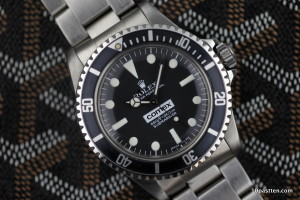
Christie’s provided some very interesting information about this watch, especially how a COMEX diver’s watch ended up with military markings of the A.R.A.
They wrote the following:
Lot Description
Rolex. An extremely rare stainless steel automatic wristwatch with sweep centre seconds, hack feature, bracelet, gas escape valve and box, made for COMEX and sold to the Argentine Navy
Signed Rolex, Oyster Perpetual, A.R.A, 660ft=200m, Submariner, COMEX issue no. 449, A.R.A. military issue no. 68507-Ci, ref. 5514, case no. 4’155’925, manufactured in 1977
Cal. 1520 nickel-finished lever movement, 26 jewels, black matte dial marked A.R.A for Armada de la República Argentina, luminous dot, baton and dagger numerals, luminous mercedes hands, luminous sweep centre seconds, tonneau-shaped water-resistant-type case, gas escape valve, revolving black bezel calibrated for 60 units, screw down crown, screw back engraved ROLEX COMEX 449 and military issue number 68507-Ci, stainless steel Rolex Oyster bracelet, case, dial and movement signed
40 mm. diam.
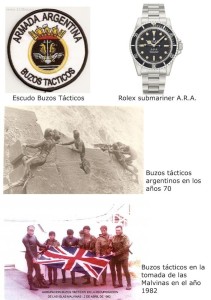
Lot Notes
With Rolex contemporary fitted green presentation box and outer packaging.
The present watch is an exceptionally rare variant of the celebrated reference 5514 made for COMEX, featuring the abbreviation “A.R.A” for “Armada de la República Argentina” (Navy of the Argentine Republic) on the dial and ARA military issue number 68507-Ci engraved on the case back. Until today unknown to the market and to literature, it is believed to be the only reference 5514 with these characteristics to appear at auction.
Reference 5514 is amongst the rarest of all Submariner models, according to literature around 150 examples were made and sold exclusively to COMEX. The model was never available to the public and differs from the regular Submariner by a variety of features, most notably the helium escape valve on the right side of the case and the serial number repeated inside the case back, a characteristic reserved to COMEX and to military watches.
According to research, collaboration between COMEX and ARA dates back to the mid 1970s when Argentina’s state-owned oil company Yacimientos Petrolíferos Fiscales or YPF started the exploration of offshore oil fields.
Prior to the purchase of a semi-submersible platform essential for such project, YPF was looking for scuba divers able to operate in depths of 180 meters. Simultaneously the Argentine Navy was also investigating the possibility of forming divers for deep-sea dives and dives with different gas mixtures, leading to an arrangement with YPF who took a group of Navy divers under contract. Research revealed that between 17 and 30 October 1977, year of manufacture of the present watch, 16 Argentine divers were trained at COMEX Hyperbaric Experimental Centre in Marseille for saturation dives to a depth of 200 meters, using Heliox gas.
It can safely be assumed that COMEX commissioned Rolex with the supply of their reference 5514 watches for the Argentine divers, requesting the inscription “A.R.A” above the depth indication on the dial instead of the commonly found “COMEX”. A wristwatch built to withstand water pressure, in the present case to a depth of 200 meters (660 feet), is a vital accessory for a deep sea diver and essential for calculating the time of dive and controlling the rate of ascent and descent.
The Argentine military issue numbers were most likely engraved to the case backs upon the return of the divers to their home country.
Formerly the property of the son of one of these divers, the present watch stands out by its unmolested, original overall condition, including the contemporary Rolex Oyster bracelet reference 93150, the correct version for reference 5514.
A short history of COMEX
The Compagnie Maritime d’Expertises (COMEX) was founded in November 1961 by Henri Germain Delauze who has been in charge ever since. The company specializes in engineering and deep diving operations.
It’s main line of business includes hyperbaric testing facilities, oceanographical research ships (Minibex and Janus) and a testing pool.
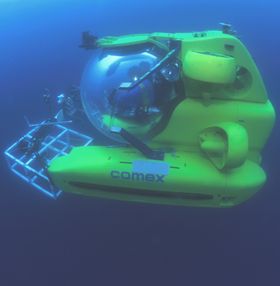
COMEX was a pioneer in the field of very deep saturation diving. They experimented with the use of hydrogen in the diver’s breathing gas. They started using Heliox and Hydreliox gas mixtures with Hydra I in 1968. This testing finally led to COMEX diver Theo Mavrostomos, with Hydra X in 1992, making a record simulated dive of 701 m in an on shore hyperbaric chamber.
The use of hydrogen was partly driven by the fact that it could help overcome the symptoms of high pressure nervous syndrome (HPNS). But another factor was that COMEX in 1987 was part of a Canadian-French consortium that tried to built the world’s first commercial nuclear mini-submarine. This submarine, Saga, was a prototype intended to be used for oil exploration and development under the Arctic ice. Saga was built on a hull originally constructed by Jacques-Yves Cousteau but not completed due to lack of funds. Saga would have a complete saturation diving system on board. The nuclear power plant would be able to produce large volumes of hydrogen and oxygen through the Electrolysis of water. This would provide plentiful amounts of breathing gas for autonomous diving operations under the Arctic ice cap.
The project suffered tax problems in Canada which caused political repercussions between the French and Canadian governments. Saga did undergo successful sea trials in 1991 but without the intended nuclear power plant. Underwater propulsion was provided by a Stirling engine and surface propulsion by a diesel engine. The project was abandoned and Saga was laid up at Marseille.
Today COMEX is still a famous company that is at the forefront of everything having to do with diving.
The following is a list of their customers:
Defence
Offshore industry
Engineering industry
University hospitals and other hospitals
Scientific research (physiology)
Search, survey, salvage and recovery operations on wrecks
Media (photography and motion pictures)
Underwater tourism
Maritime expertise
Underwater archaeology
Hydrography
Salvage
Insurance
A short history of A.R.A.
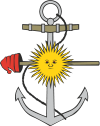
The Argentine Navy or Navy of the Argentine Republic or Armada of the Argentine Republic (Spanish: Armada de la República Argentina — ARA, also Armada Argentina) is the navy of Argentina. It is one of the three branches of the Armed Forces of the Argentine Republic, together with the Army and the Air Force. Each ship of the Argentine Navy is designated with the prefix “ARA” before its name.
The Argentine Navy day is celebrated on May 17, anniversary of the victory achieved in 1814 in the Battle of Montevideo over the Spanish fleet during the war of Independence.
19th century
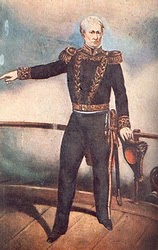
Pic.: Admiral William Brown.
The Argentine Navy was created in the aftermath of the May Revolution of May 25, 1810, which started the war for independence from Spain. The first navy was created to support Manuel Belgrano at the Paraguay campaign, but it was sunk by ships from Montevideo, and did not take part in that conflict. Renewed conflicts with Montevideo led to the creation of a second one, which captured the city. As Buenos Aires had little maritime history, most men in the navy were from other nations, such as the Irish admiral William Brown, who directed the operation.
As the cost of maintaining a navy was too high, most of the Argentine naval forces were composed of privateers. Brown led the Argentine navy in further naval conflicts at the War with Brazil and the Anglo-French blockade of the Río de la Plata.
In the late 1800s, the Argentine Navy began modernizing itself. At the close of the century, the force included:
5 armoured cruisers
4 coastal defence ironclads
3 second-class, high-speed, British-built cruisers
7 modern small cruisers and gunboats
4 destroyers and
22 torpedo boats.
The most powerful ships (counted in the list above) included the Italian-built Garibaldi and her sister ships, the General Belgrano, Pueyrredón, and the San Martín, each at over 6,000 tons. Three older ships, the Almirante Brown, Independencia, and the Libertad dated from the 1880s and early 1890s.
The navy’s ships were built primarily in Italy, Britain, France, and Spain and were operated by over 600 officers and 7760 seamen. These were supported by a battalion of marines and an artillery battery.
Today
The Argentine Navy participates in joint exercises with other friendly navies like Brazil, United States, Spain, France, Canada, South Africa,[14] Italy, Uruguay, and since the 1990s, Chile. They are also routinely held, in order to develop a common operational doctrine. Every year in conjunction with the Chilean Navy the Argentine Navy participate in the Patrulla Antártica Naval Combinada (English: Joint Antarctic Naval Patrol) to guarantee safety to all touristic and scientific ships that are in transit within the Antarctic Peninsula where the Navy is also directly responsible of maintaining the Argentine bases there.
Jaap Bakker
